Conflict Resolution Techniques in Organizations
VerifiedAdded on 2023/04/04
|8
|2641
|338
AI Summary
This essay analyzes different conflict resolution techniques used in organizations and emphasizes the role of HR professionals in resolving conflicts. It explores traditional negotiation, interest-based approaches, and restorative approaches. The essay also highlights the importance of effective communication skills for HR professionals in negotiation and conflict resolution.
Contribute Materials
Your contribution can guide someone’s learning journey. Share your
documents today.
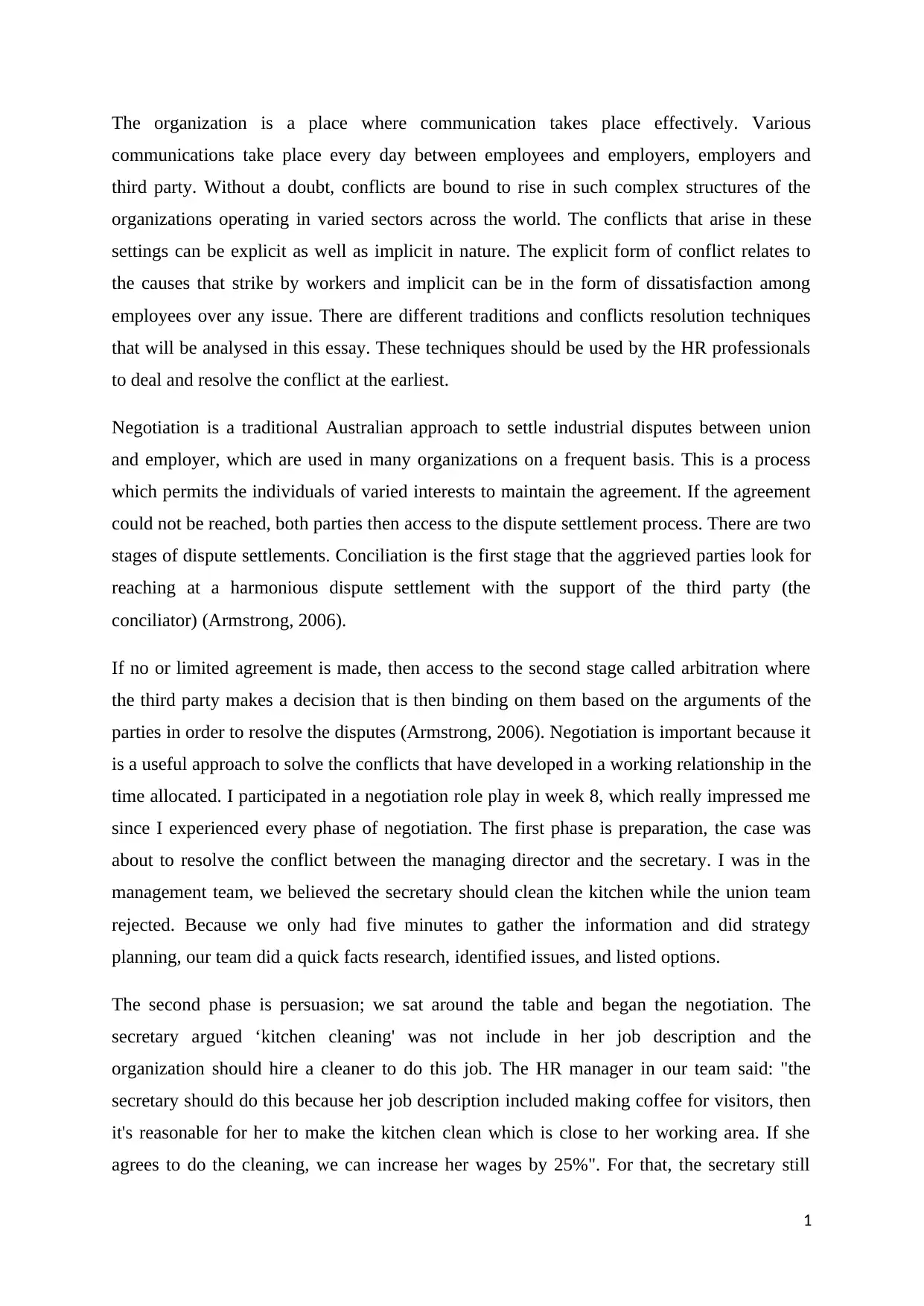
The organization is a place where communication takes place effectively. Various
communications take place every day between employees and employers, employers and
third party. Without a doubt, conflicts are bound to rise in such complex structures of the
organizations operating in varied sectors across the world. The conflicts that arise in these
settings can be explicit as well as implicit in nature. The explicit form of conflict relates to
the causes that strike by workers and implicit can be in the form of dissatisfaction among
employees over any issue. There are different traditions and conflicts resolution techniques
that will be analysed in this essay. These techniques should be used by the HR professionals
to deal and resolve the conflict at the earliest.
Negotiation is a traditional Australian approach to settle industrial disputes between union
and employer, which are used in many organizations on a frequent basis. This is a process
which permits the individuals of varied interests to maintain the agreement. If the agreement
could not be reached, both parties then access to the dispute settlement process. There are two
stages of dispute settlements. Conciliation is the first stage that the aggrieved parties look for
reaching at a harmonious dispute settlement with the support of the third party (the
conciliator) (Armstrong, 2006).
If no or limited agreement is made, then access to the second stage called arbitration where
the third party makes a decision that is then binding on them based on the arguments of the
parties in order to resolve the disputes (Armstrong, 2006). Negotiation is important because it
is a useful approach to solve the conflicts that have developed in a working relationship in the
time allocated. I participated in a negotiation role play in week 8, which really impressed me
since I experienced every phase of negotiation. The first phase is preparation, the case was
about to resolve the conflict between the managing director and the secretary. I was in the
management team, we believed the secretary should clean the kitchen while the union team
rejected. Because we only had five minutes to gather the information and did strategy
planning, our team did a quick facts research, identified issues, and listed options.
The second phase is persuasion; we sat around the table and began the negotiation. The
secretary argued ‘kitchen cleaning' was not include in her job description and the
organization should hire a cleaner to do this job. The HR manager in our team said: "the
secretary should do this because her job description included making coffee for visitors, then
it's reasonable for her to make the kitchen clean which is close to her working area. If she
agrees to do the cleaning, we can increase her wages by 25%". For that, the secretary still
1
communications take place every day between employees and employers, employers and
third party. Without a doubt, conflicts are bound to rise in such complex structures of the
organizations operating in varied sectors across the world. The conflicts that arise in these
settings can be explicit as well as implicit in nature. The explicit form of conflict relates to
the causes that strike by workers and implicit can be in the form of dissatisfaction among
employees over any issue. There are different traditions and conflicts resolution techniques
that will be analysed in this essay. These techniques should be used by the HR professionals
to deal and resolve the conflict at the earliest.
Negotiation is a traditional Australian approach to settle industrial disputes between union
and employer, which are used in many organizations on a frequent basis. This is a process
which permits the individuals of varied interests to maintain the agreement. If the agreement
could not be reached, both parties then access to the dispute settlement process. There are two
stages of dispute settlements. Conciliation is the first stage that the aggrieved parties look for
reaching at a harmonious dispute settlement with the support of the third party (the
conciliator) (Armstrong, 2006).
If no or limited agreement is made, then access to the second stage called arbitration where
the third party makes a decision that is then binding on them based on the arguments of the
parties in order to resolve the disputes (Armstrong, 2006). Negotiation is important because it
is a useful approach to solve the conflicts that have developed in a working relationship in the
time allocated. I participated in a negotiation role play in week 8, which really impressed me
since I experienced every phase of negotiation. The first phase is preparation, the case was
about to resolve the conflict between the managing director and the secretary. I was in the
management team, we believed the secretary should clean the kitchen while the union team
rejected. Because we only had five minutes to gather the information and did strategy
planning, our team did a quick facts research, identified issues, and listed options.
The second phase is persuasion; we sat around the table and began the negotiation. The
secretary argued ‘kitchen cleaning' was not include in her job description and the
organization should hire a cleaner to do this job. The HR manager in our team said: "the
secretary should do this because her job description included making coffee for visitors, then
it's reasonable for her to make the kitchen clean which is close to her working area. If she
agrees to do the cleaning, we can increase her wages by 25%". For that, the secretary still
1
Secure Best Marks with AI Grader
Need help grading? Try our AI Grader for instant feedback on your assignments.
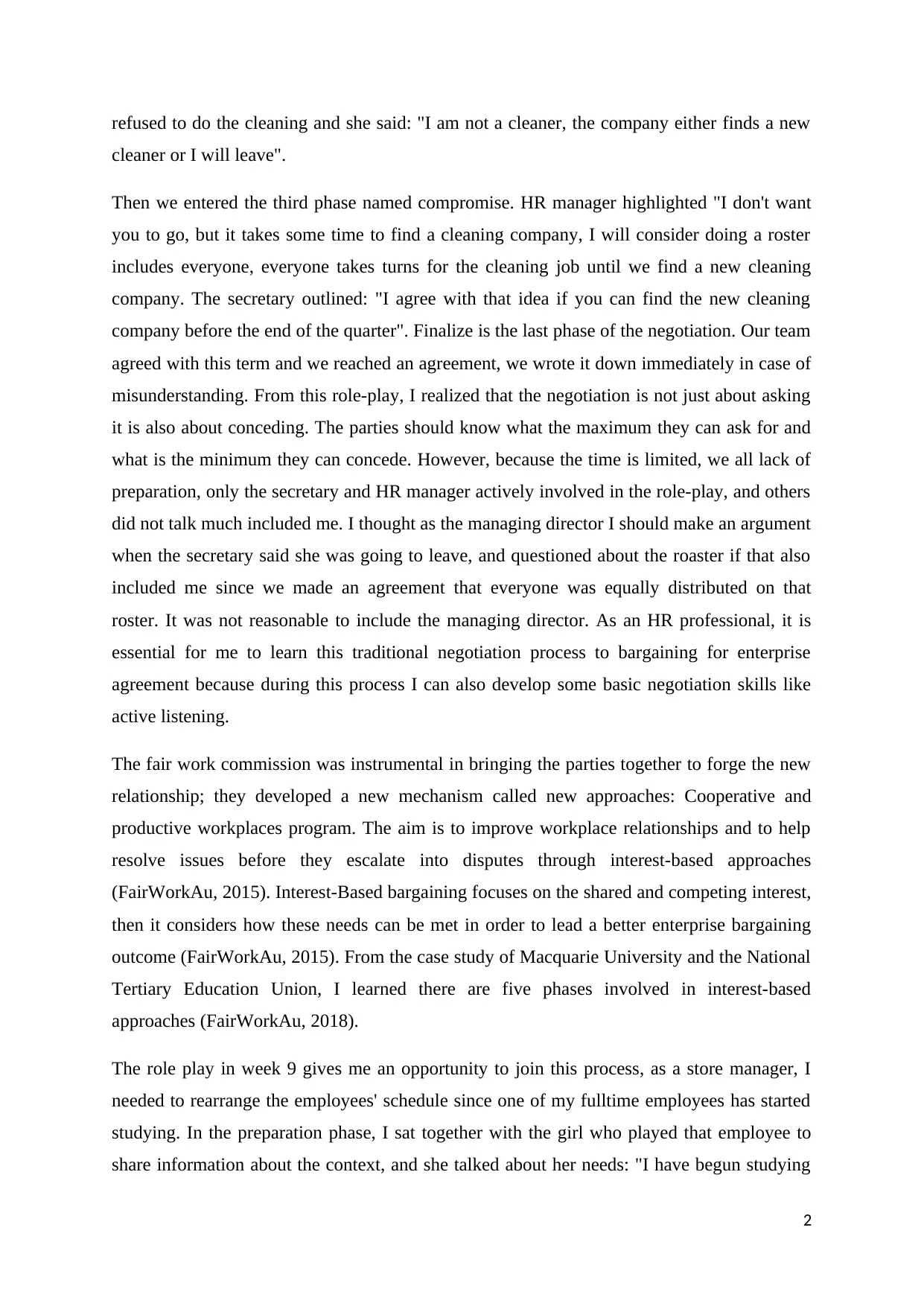
refused to do the cleaning and she said: "I am not a cleaner, the company either finds a new
cleaner or I will leave".
Then we entered the third phase named compromise. HR manager highlighted "I don't want
you to go, but it takes some time to find a cleaning company, I will consider doing a roster
includes everyone, everyone takes turns for the cleaning job until we find a new cleaning
company. The secretary outlined: "I agree with that idea if you can find the new cleaning
company before the end of the quarter". Finalize is the last phase of the negotiation. Our team
agreed with this term and we reached an agreement, we wrote it down immediately in case of
misunderstanding. From this role-play, I realized that the negotiation is not just about asking
it is also about conceding. The parties should know what the maximum they can ask for and
what is the minimum they can concede. However, because the time is limited, we all lack of
preparation, only the secretary and HR manager actively involved in the role-play, and others
did not talk much included me. I thought as the managing director I should make an argument
when the secretary said she was going to leave, and questioned about the roaster if that also
included me since we made an agreement that everyone was equally distributed on that
roster. It was not reasonable to include the managing director. As an HR professional, it is
essential for me to learn this traditional negotiation process to bargaining for enterprise
agreement because during this process I can also develop some basic negotiation skills like
active listening.
The fair work commission was instrumental in bringing the parties together to forge the new
relationship; they developed a new mechanism called new approaches: Cooperative and
productive workplaces program. The aim is to improve workplace relationships and to help
resolve issues before they escalate into disputes through interest-based approaches
(FairWorkAu, 2015). Interest-Based bargaining focuses on the shared and competing interest,
then it considers how these needs can be met in order to lead a better enterprise bargaining
outcome (FairWorkAu, 2015). From the case study of Macquarie University and the National
Tertiary Education Union, I learned there are five phases involved in interest-based
approaches (FairWorkAu, 2018).
The role play in week 9 gives me an opportunity to join this process, as a store manager, I
needed to rearrange the employees' schedule since one of my fulltime employees has started
studying. In the preparation phase, I sat together with the girl who played that employee to
share information about the context, and she talked about her needs: "I have begun studying
2
cleaner or I will leave".
Then we entered the third phase named compromise. HR manager highlighted "I don't want
you to go, but it takes some time to find a cleaning company, I will consider doing a roster
includes everyone, everyone takes turns for the cleaning job until we find a new cleaning
company. The secretary outlined: "I agree with that idea if you can find the new cleaning
company before the end of the quarter". Finalize is the last phase of the negotiation. Our team
agreed with this term and we reached an agreement, we wrote it down immediately in case of
misunderstanding. From this role-play, I realized that the negotiation is not just about asking
it is also about conceding. The parties should know what the maximum they can ask for and
what is the minimum they can concede. However, because the time is limited, we all lack of
preparation, only the secretary and HR manager actively involved in the role-play, and others
did not talk much included me. I thought as the managing director I should make an argument
when the secretary said she was going to leave, and questioned about the roaster if that also
included me since we made an agreement that everyone was equally distributed on that
roster. It was not reasonable to include the managing director. As an HR professional, it is
essential for me to learn this traditional negotiation process to bargaining for enterprise
agreement because during this process I can also develop some basic negotiation skills like
active listening.
The fair work commission was instrumental in bringing the parties together to forge the new
relationship; they developed a new mechanism called new approaches: Cooperative and
productive workplaces program. The aim is to improve workplace relationships and to help
resolve issues before they escalate into disputes through interest-based approaches
(FairWorkAu, 2015). Interest-Based bargaining focuses on the shared and competing interest,
then it considers how these needs can be met in order to lead a better enterprise bargaining
outcome (FairWorkAu, 2015). From the case study of Macquarie University and the National
Tertiary Education Union, I learned there are five phases involved in interest-based
approaches (FairWorkAu, 2018).
The role play in week 9 gives me an opportunity to join this process, as a store manager, I
needed to rearrange the employees' schedule since one of my fulltime employees has started
studying. In the preparation phase, I sat together with the girl who played that employee to
share information about the context, and she talked about her needs: "I have begun studying
2
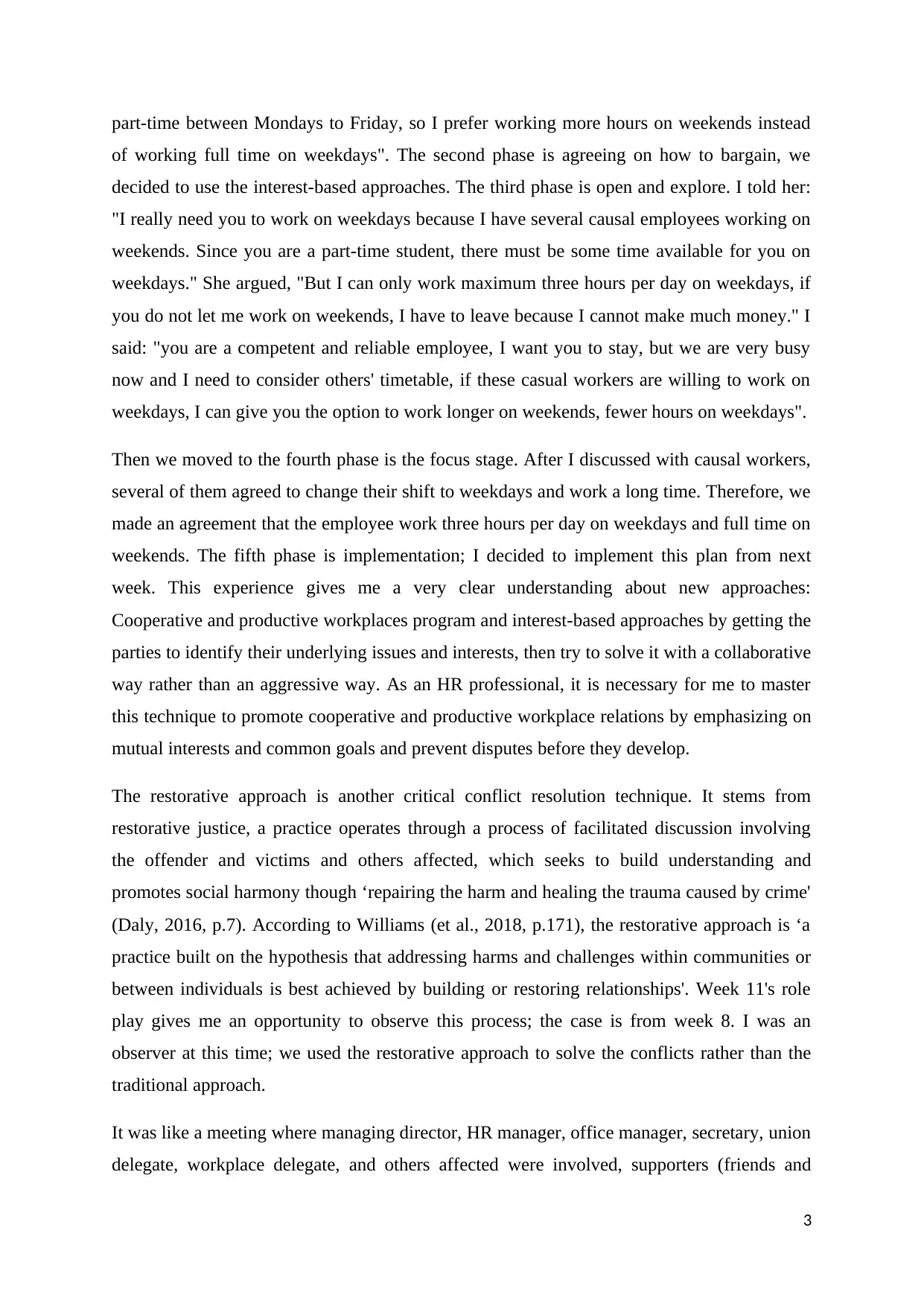
part-time between Mondays to Friday, so I prefer working more hours on weekends instead
of working full time on weekdays". The second phase is agreeing on how to bargain, we
decided to use the interest-based approaches. The third phase is open and explore. I told her:
"I really need you to work on weekdays because I have several causal employees working on
weekends. Since you are a part-time student, there must be some time available for you on
weekdays." She argued, "But I can only work maximum three hours per day on weekdays, if
you do not let me work on weekends, I have to leave because I cannot make much money." I
said: "you are a competent and reliable employee, I want you to stay, but we are very busy
now and I need to consider others' timetable, if these casual workers are willing to work on
weekdays, I can give you the option to work longer on weekends, fewer hours on weekdays".
Then we moved to the fourth phase is the focus stage. After I discussed with causal workers,
several of them agreed to change their shift to weekdays and work a long time. Therefore, we
made an agreement that the employee work three hours per day on weekdays and full time on
weekends. The fifth phase is implementation; I decided to implement this plan from next
week. This experience gives me a very clear understanding about new approaches:
Cooperative and productive workplaces program and interest-based approaches by getting the
parties to identify their underlying issues and interests, then try to solve it with a collaborative
way rather than an aggressive way. As an HR professional, it is necessary for me to master
this technique to promote cooperative and productive workplace relations by emphasizing on
mutual interests and common goals and prevent disputes before they develop.
The restorative approach is another critical conflict resolution technique. It stems from
restorative justice, a practice operates through a process of facilitated discussion involving
the offender and victims and others affected, which seeks to build understanding and
promotes social harmony though ‘repairing the harm and healing the trauma caused by crime'
(Daly, 2016, p.7). According to Williams (et al., 2018, p.171), the restorative approach is ‘a
practice built on the hypothesis that addressing harms and challenges within communities or
between individuals is best achieved by building or restoring relationships'. Week 11's role
play gives me an opportunity to observe this process; the case is from week 8. I was an
observer at this time; we used the restorative approach to solve the conflicts rather than the
traditional approach.
It was like a meeting where managing director, HR manager, office manager, secretary, union
delegate, workplace delegate, and others affected were involved, supporters (friends and
3
of working full time on weekdays". The second phase is agreeing on how to bargain, we
decided to use the interest-based approaches. The third phase is open and explore. I told her:
"I really need you to work on weekdays because I have several causal employees working on
weekends. Since you are a part-time student, there must be some time available for you on
weekdays." She argued, "But I can only work maximum three hours per day on weekdays, if
you do not let me work on weekends, I have to leave because I cannot make much money." I
said: "you are a competent and reliable employee, I want you to stay, but we are very busy
now and I need to consider others' timetable, if these casual workers are willing to work on
weekdays, I can give you the option to work longer on weekends, fewer hours on weekdays".
Then we moved to the fourth phase is the focus stage. After I discussed with causal workers,
several of them agreed to change their shift to weekdays and work a long time. Therefore, we
made an agreement that the employee work three hours per day on weekdays and full time on
weekends. The fifth phase is implementation; I decided to implement this plan from next
week. This experience gives me a very clear understanding about new approaches:
Cooperative and productive workplaces program and interest-based approaches by getting the
parties to identify their underlying issues and interests, then try to solve it with a collaborative
way rather than an aggressive way. As an HR professional, it is necessary for me to master
this technique to promote cooperative and productive workplace relations by emphasizing on
mutual interests and common goals and prevent disputes before they develop.
The restorative approach is another critical conflict resolution technique. It stems from
restorative justice, a practice operates through a process of facilitated discussion involving
the offender and victims and others affected, which seeks to build understanding and
promotes social harmony though ‘repairing the harm and healing the trauma caused by crime'
(Daly, 2016, p.7). According to Williams (et al., 2018, p.171), the restorative approach is ‘a
practice built on the hypothesis that addressing harms and challenges within communities or
between individuals is best achieved by building or restoring relationships'. Week 11's role
play gives me an opportunity to observe this process; the case is from week 8. I was an
observer at this time; we used the restorative approach to solve the conflicts rather than the
traditional approach.
It was like a meeting where managing director, HR manager, office manager, secretary, union
delegate, workplace delegate, and others affected were involved, supporters (friends and
3
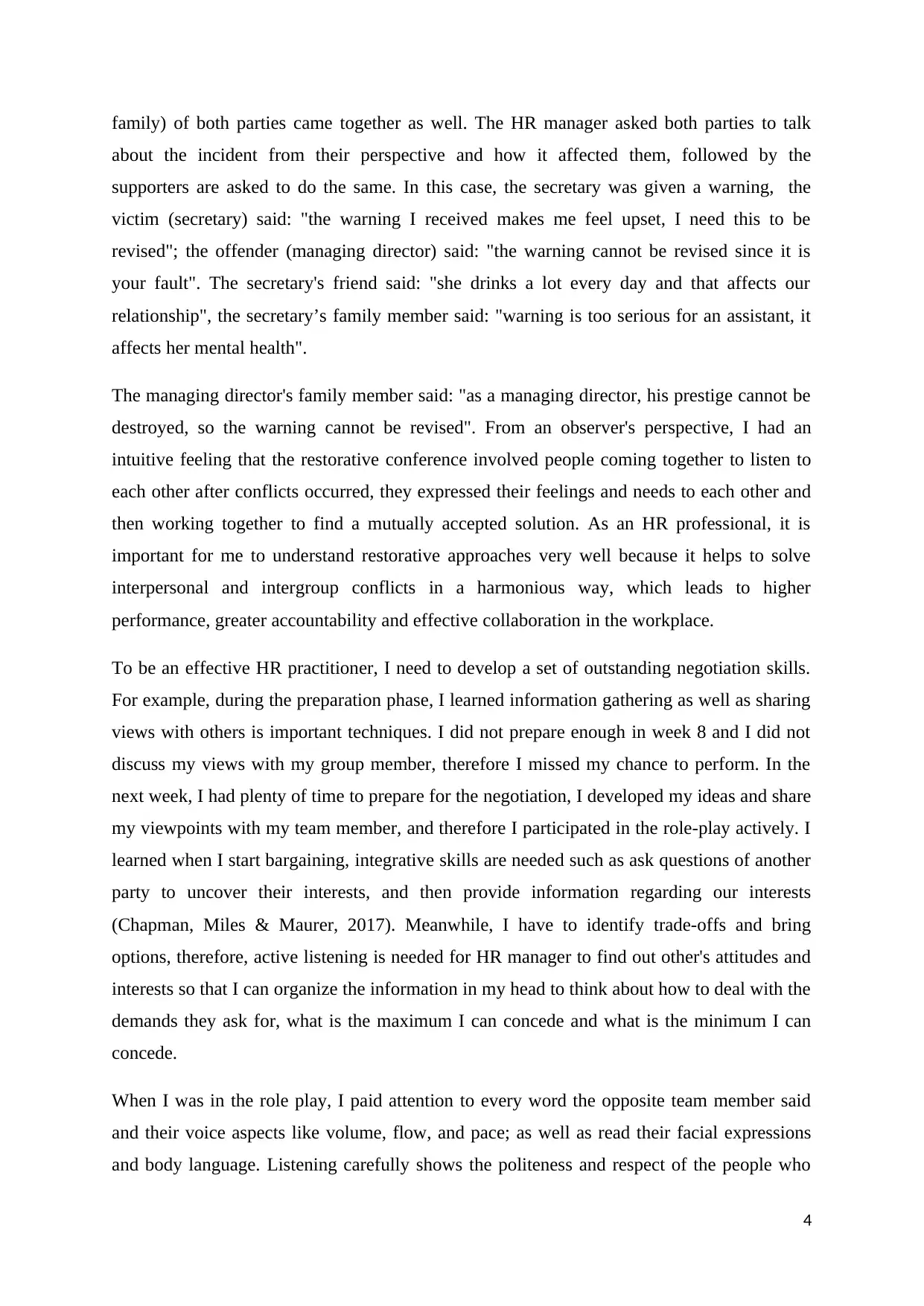
family) of both parties came together as well. The HR manager asked both parties to talk
about the incident from their perspective and how it affected them, followed by the
supporters are asked to do the same. In this case, the secretary was given a warning, the
victim (secretary) said: "the warning I received makes me feel upset, I need this to be
revised"; the offender (managing director) said: "the warning cannot be revised since it is
your fault". The secretary's friend said: "she drinks a lot every day and that affects our
relationship", the secretary’s family member said: "warning is too serious for an assistant, it
affects her mental health".
The managing director's family member said: "as a managing director, his prestige cannot be
destroyed, so the warning cannot be revised". From an observer's perspective, I had an
intuitive feeling that the restorative conference involved people coming together to listen to
each other after conflicts occurred, they expressed their feelings and needs to each other and
then working together to find a mutually accepted solution. As an HR professional, it is
important for me to understand restorative approaches very well because it helps to solve
interpersonal and intergroup conflicts in a harmonious way, which leads to higher
performance, greater accountability and effective collaboration in the workplace.
To be an effective HR practitioner, I need to develop a set of outstanding negotiation skills.
For example, during the preparation phase, I learned information gathering as well as sharing
views with others is important techniques. I did not prepare enough in week 8 and I did not
discuss my views with my group member, therefore I missed my chance to perform. In the
next week, I had plenty of time to prepare for the negotiation, I developed my ideas and share
my viewpoints with my team member, and therefore I participated in the role-play actively. I
learned when I start bargaining, integrative skills are needed such as ask questions of another
party to uncover their interests, and then provide information regarding our interests
(Chapman, Miles & Maurer, 2017). Meanwhile, I have to identify trade-offs and bring
options, therefore, active listening is needed for HR manager to find out other's attitudes and
interests so that I can organize the information in my head to think about how to deal with the
demands they ask for, what is the maximum I can concede and what is the minimum I can
concede.
When I was in the role play, I paid attention to every word the opposite team member said
and their voice aspects like volume, flow, and pace; as well as read their facial expressions
and body language. Listening carefully shows the politeness and respect of the people who
4
about the incident from their perspective and how it affected them, followed by the
supporters are asked to do the same. In this case, the secretary was given a warning, the
victim (secretary) said: "the warning I received makes me feel upset, I need this to be
revised"; the offender (managing director) said: "the warning cannot be revised since it is
your fault". The secretary's friend said: "she drinks a lot every day and that affects our
relationship", the secretary’s family member said: "warning is too serious for an assistant, it
affects her mental health".
The managing director's family member said: "as a managing director, his prestige cannot be
destroyed, so the warning cannot be revised". From an observer's perspective, I had an
intuitive feeling that the restorative conference involved people coming together to listen to
each other after conflicts occurred, they expressed their feelings and needs to each other and
then working together to find a mutually accepted solution. As an HR professional, it is
important for me to understand restorative approaches very well because it helps to solve
interpersonal and intergroup conflicts in a harmonious way, which leads to higher
performance, greater accountability and effective collaboration in the workplace.
To be an effective HR practitioner, I need to develop a set of outstanding negotiation skills.
For example, during the preparation phase, I learned information gathering as well as sharing
views with others is important techniques. I did not prepare enough in week 8 and I did not
discuss my views with my group member, therefore I missed my chance to perform. In the
next week, I had plenty of time to prepare for the negotiation, I developed my ideas and share
my viewpoints with my team member, and therefore I participated in the role-play actively. I
learned when I start bargaining, integrative skills are needed such as ask questions of another
party to uncover their interests, and then provide information regarding our interests
(Chapman, Miles & Maurer, 2017). Meanwhile, I have to identify trade-offs and bring
options, therefore, active listening is needed for HR manager to find out other's attitudes and
interests so that I can organize the information in my head to think about how to deal with the
demands they ask for, what is the maximum I can concede and what is the minimum I can
concede.
When I was in the role play, I paid attention to every word the opposite team member said
and their voice aspects like volume, flow, and pace; as well as read their facial expressions
and body language. Listening carefully shows the politeness and respect of the people who
4
Secure Best Marks with AI Grader
Need help grading? Try our AI Grader for instant feedback on your assignments.

involved in the bargaining, it is a basic professional quality and a virtue for every successful
human resource manager (Madjoski, 2016). In addition, verbal communication skill is
required to make propositions from statements to exploration by use of signals and
concessions, "if you do…, then we would consider doing" is a very useful sentence pattern. I
learned the speech must be concise and the main point should be emphasized often such as
focusing the benefit to the other party.
Nonverbal communication is also crucial, which includes facial expression, body movements
and eye contact (Stoica, 2014). The body postures and the gestures reveal the negotiator's
feelings and emotions, that is why I was paying attention to other's nonverbal language, I
learned from the role play that the better I understood other's nonverbal language, the more
this can be used to the advantage of my side. Likewise, I have to manage my own non-verbal
language during bargaining in order not to send out negative vibes. Moreover, the facial
expressions and body posture may have different meanings in different cultures, the HR
professional must investigate the cultural background of the opposite party to figure out what
non-verbal behavior is appropriate (Čulo & Skendrović, 2012). Overall, HR professionals
need to understand how to communicate effectively, good communication is the most
essential prerequisite for successful negotiations and resolves conflicts.
On the other hand, from week 10's role play, I learned HR professionals need to ensure the
policy they made during the negotiation to comply with fair work act and occupational health
and safety act in the workplace. For example, the fair work commission has regulated a 3.0%
increase to minimum wage starting 1 July 2019, when making the enterprise agreement, HR
professionals must be aware of that (Fair Work Ombudsman, 2019). In this case study, we
need to handle the expense allowance for distant work and change of locations. I was in the
management team, the employees' team asked relocation allowance should be paid and one
return trip home should be compensated. I learned that the HR professionals should check
with the relevant department to seek in-principle approval of costs that are to be reimbursed,
prior to any decision being taken (Australian Government Department of Finance, 2019).
Therefore, enough preparation is required before bargaining. And, when negotiating the
relocation allowance of the employees, HR professionals must be patient and listen to the
employees' opinion based on their individual circumstances.
In conclusion, an HR's effective negotiation can be constituted by the outcome that most
benefits the organization. I learned in this course that there are several conflict resolution
5
human resource manager (Madjoski, 2016). In addition, verbal communication skill is
required to make propositions from statements to exploration by use of signals and
concessions, "if you do…, then we would consider doing" is a very useful sentence pattern. I
learned the speech must be concise and the main point should be emphasized often such as
focusing the benefit to the other party.
Nonverbal communication is also crucial, which includes facial expression, body movements
and eye contact (Stoica, 2014). The body postures and the gestures reveal the negotiator's
feelings and emotions, that is why I was paying attention to other's nonverbal language, I
learned from the role play that the better I understood other's nonverbal language, the more
this can be used to the advantage of my side. Likewise, I have to manage my own non-verbal
language during bargaining in order not to send out negative vibes. Moreover, the facial
expressions and body posture may have different meanings in different cultures, the HR
professional must investigate the cultural background of the opposite party to figure out what
non-verbal behavior is appropriate (Čulo & Skendrović, 2012). Overall, HR professionals
need to understand how to communicate effectively, good communication is the most
essential prerequisite for successful negotiations and resolves conflicts.
On the other hand, from week 10's role play, I learned HR professionals need to ensure the
policy they made during the negotiation to comply with fair work act and occupational health
and safety act in the workplace. For example, the fair work commission has regulated a 3.0%
increase to minimum wage starting 1 July 2019, when making the enterprise agreement, HR
professionals must be aware of that (Fair Work Ombudsman, 2019). In this case study, we
need to handle the expense allowance for distant work and change of locations. I was in the
management team, the employees' team asked relocation allowance should be paid and one
return trip home should be compensated. I learned that the HR professionals should check
with the relevant department to seek in-principle approval of costs that are to be reimbursed,
prior to any decision being taken (Australian Government Department of Finance, 2019).
Therefore, enough preparation is required before bargaining. And, when negotiating the
relocation allowance of the employees, HR professionals must be patient and listen to the
employees' opinion based on their individual circumstances.
In conclusion, an HR's effective negotiation can be constituted by the outcome that most
benefits the organization. I learned in this course that there are several conflict resolution
5
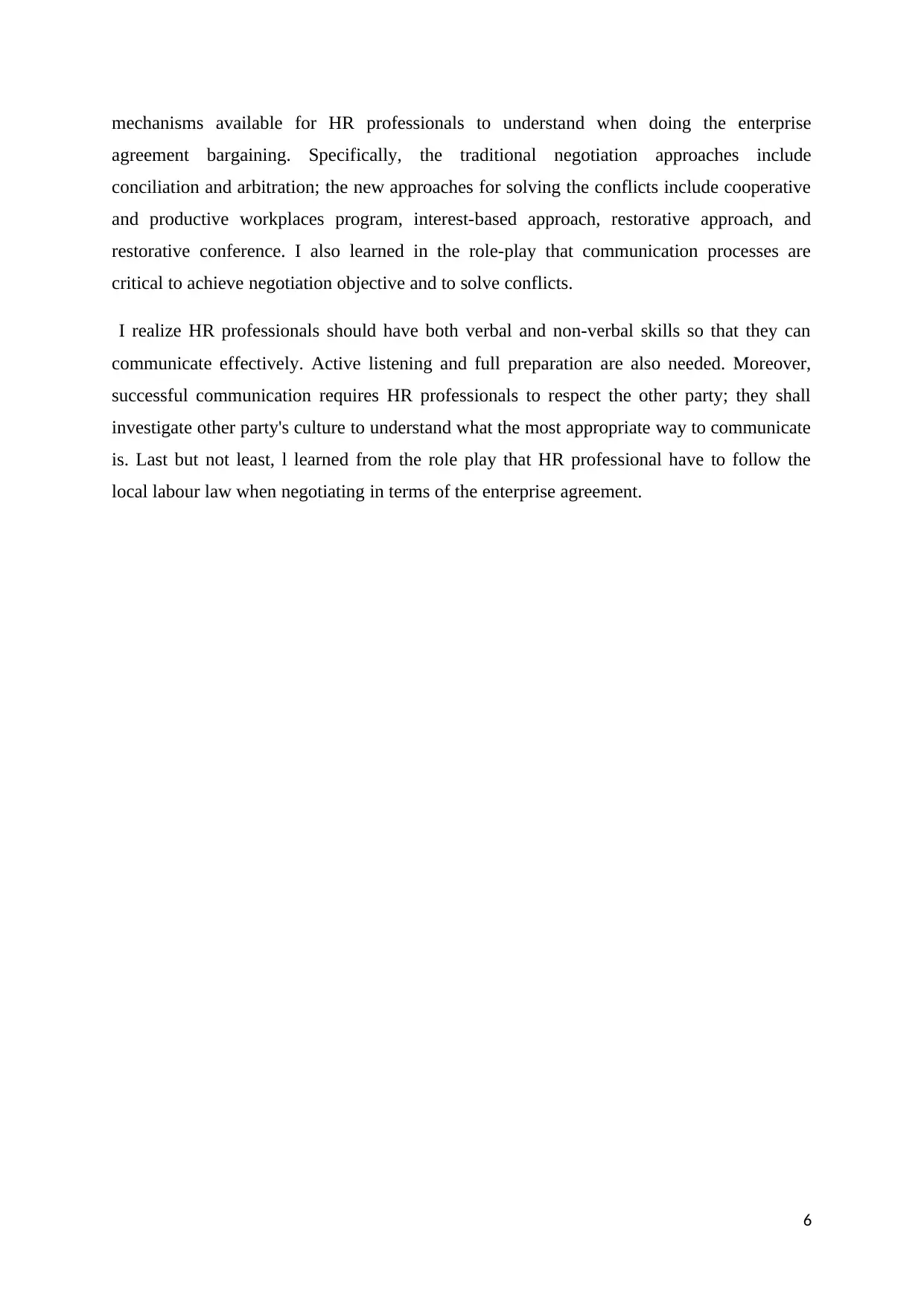
mechanisms available for HR professionals to understand when doing the enterprise
agreement bargaining. Specifically, the traditional negotiation approaches include
conciliation and arbitration; the new approaches for solving the conflicts include cooperative
and productive workplaces program, interest-based approach, restorative approach, and
restorative conference. I also learned in the role-play that communication processes are
critical to achieve negotiation objective and to solve conflicts.
I realize HR professionals should have both verbal and non-verbal skills so that they can
communicate effectively. Active listening and full preparation are also needed. Moreover,
successful communication requires HR professionals to respect the other party; they shall
investigate other party's culture to understand what the most appropriate way to communicate
is. Last but not least, l learned from the role play that HR professional have to follow the
local labour law when negotiating in terms of the enterprise agreement.
6
agreement bargaining. Specifically, the traditional negotiation approaches include
conciliation and arbitration; the new approaches for solving the conflicts include cooperative
and productive workplaces program, interest-based approach, restorative approach, and
restorative conference. I also learned in the role-play that communication processes are
critical to achieve negotiation objective and to solve conflicts.
I realize HR professionals should have both verbal and non-verbal skills so that they can
communicate effectively. Active listening and full preparation are also needed. Moreover,
successful communication requires HR professionals to respect the other party; they shall
investigate other party's culture to understand what the most appropriate way to communicate
is. Last but not least, l learned from the role play that HR professional have to follow the
local labour law when negotiating in terms of the enterprise agreement.
6
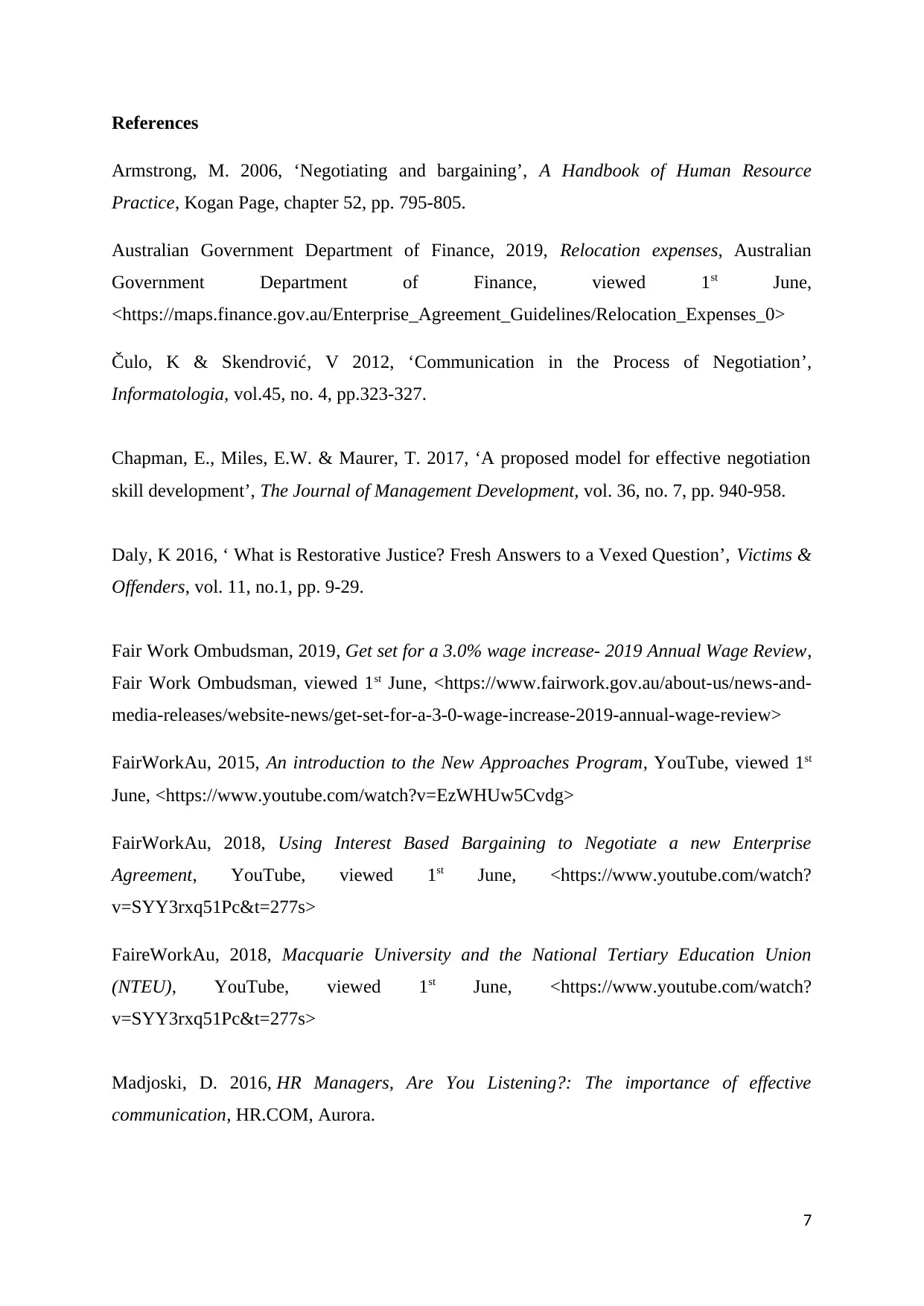
References
Armstrong, M. 2006, ‘Negotiating and bargaining’, A Handbook of Human Resource
Practice, Kogan Page, chapter 52, pp. 795-805.
Australian Government Department of Finance, 2019, Relocation expenses, Australian
Government Department of Finance, viewed 1st June,
<https://maps.finance.gov.au/Enterprise_Agreement_Guidelines/Relocation_Expenses_0>
Čulo, K & Skendrović, V 2012, ‘Communication in the Process of Negotiation’,
Informatologia, vol.45, no. 4, pp.323-327.
Chapman, E., Miles, E.W. & Maurer, T. 2017, ‘A proposed model for effective negotiation
skill development’, The Journal of Management Development, vol. 36, no. 7, pp. 940-958.
Daly, K 2016, ‘ What is Restorative Justice? Fresh Answers to a Vexed Question’, Victims &
Offenders, vol. 11, no.1, pp. 9-29.
Fair Work Ombudsman, 2019, Get set for a 3.0% wage increase- 2019 Annual Wage Review,
Fair Work Ombudsman, viewed 1st June, <https://www.fairwork.gov.au/about-us/news-and-
media-releases/website-news/get-set-for-a-3-0-wage-increase-2019-annual-wage-review>
FairWorkAu, 2015, An introduction to the New Approaches Program, YouTube, viewed 1st
June, <https://www.youtube.com/watch?v=EzWHUw5Cvdg>
FairWorkAu, 2018, Using Interest Based Bargaining to Negotiate a new Enterprise
Agreement, YouTube, viewed 1st June, <https://www.youtube.com/watch?
v=SYY3rxq51Pc&t=277s>
FaireWorkAu, 2018, Macquarie University and the National Tertiary Education Union
(NTEU), YouTube, viewed 1st June, <https://www.youtube.com/watch?
v=SYY3rxq51Pc&t=277s>
Madjoski, D. 2016, HR Managers, Are You Listening?: The importance of effective
communication, HR.COM, Aurora.
7
Armstrong, M. 2006, ‘Negotiating and bargaining’, A Handbook of Human Resource
Practice, Kogan Page, chapter 52, pp. 795-805.
Australian Government Department of Finance, 2019, Relocation expenses, Australian
Government Department of Finance, viewed 1st June,
<https://maps.finance.gov.au/Enterprise_Agreement_Guidelines/Relocation_Expenses_0>
Čulo, K & Skendrović, V 2012, ‘Communication in the Process of Negotiation’,
Informatologia, vol.45, no. 4, pp.323-327.
Chapman, E., Miles, E.W. & Maurer, T. 2017, ‘A proposed model for effective negotiation
skill development’, The Journal of Management Development, vol. 36, no. 7, pp. 940-958.
Daly, K 2016, ‘ What is Restorative Justice? Fresh Answers to a Vexed Question’, Victims &
Offenders, vol. 11, no.1, pp. 9-29.
Fair Work Ombudsman, 2019, Get set for a 3.0% wage increase- 2019 Annual Wage Review,
Fair Work Ombudsman, viewed 1st June, <https://www.fairwork.gov.au/about-us/news-and-
media-releases/website-news/get-set-for-a-3-0-wage-increase-2019-annual-wage-review>
FairWorkAu, 2015, An introduction to the New Approaches Program, YouTube, viewed 1st
June, <https://www.youtube.com/watch?v=EzWHUw5Cvdg>
FairWorkAu, 2018, Using Interest Based Bargaining to Negotiate a new Enterprise
Agreement, YouTube, viewed 1st June, <https://www.youtube.com/watch?
v=SYY3rxq51Pc&t=277s>
FaireWorkAu, 2018, Macquarie University and the National Tertiary Education Union
(NTEU), YouTube, viewed 1st June, <https://www.youtube.com/watch?
v=SYY3rxq51Pc&t=277s>
Madjoski, D. 2016, HR Managers, Are You Listening?: The importance of effective
communication, HR.COM, Aurora.
7
Paraphrase This Document
Need a fresh take? Get an instant paraphrase of this document with our AI Paraphraser

Stoica, A 2014, ‘Communication in the Context of the Negotiation Process’, Practical
Application of Science, vol. 2, pp. 389-394.
Williams, A, Reed, H, Rees, G, Segrott, J 2018, ‘Improving relationship- based practice,
practitioner confidence and family engagement skills through restorative approach training’
Children and Youth Services Review, vol. 93, pp. 170-177.
8
Application of Science, vol. 2, pp. 389-394.
Williams, A, Reed, H, Rees, G, Segrott, J 2018, ‘Improving relationship- based practice,
practitioner confidence and family engagement skills through restorative approach training’
Children and Youth Services Review, vol. 93, pp. 170-177.
8
1 out of 8
Your All-in-One AI-Powered Toolkit for Academic Success.
+13062052269
info@desklib.com
Available 24*7 on WhatsApp / Email
![[object Object]](/_next/static/media/star-bottom.7253800d.svg)
Unlock your academic potential
© 2024 | Zucol Services PVT LTD | All rights reserved.
